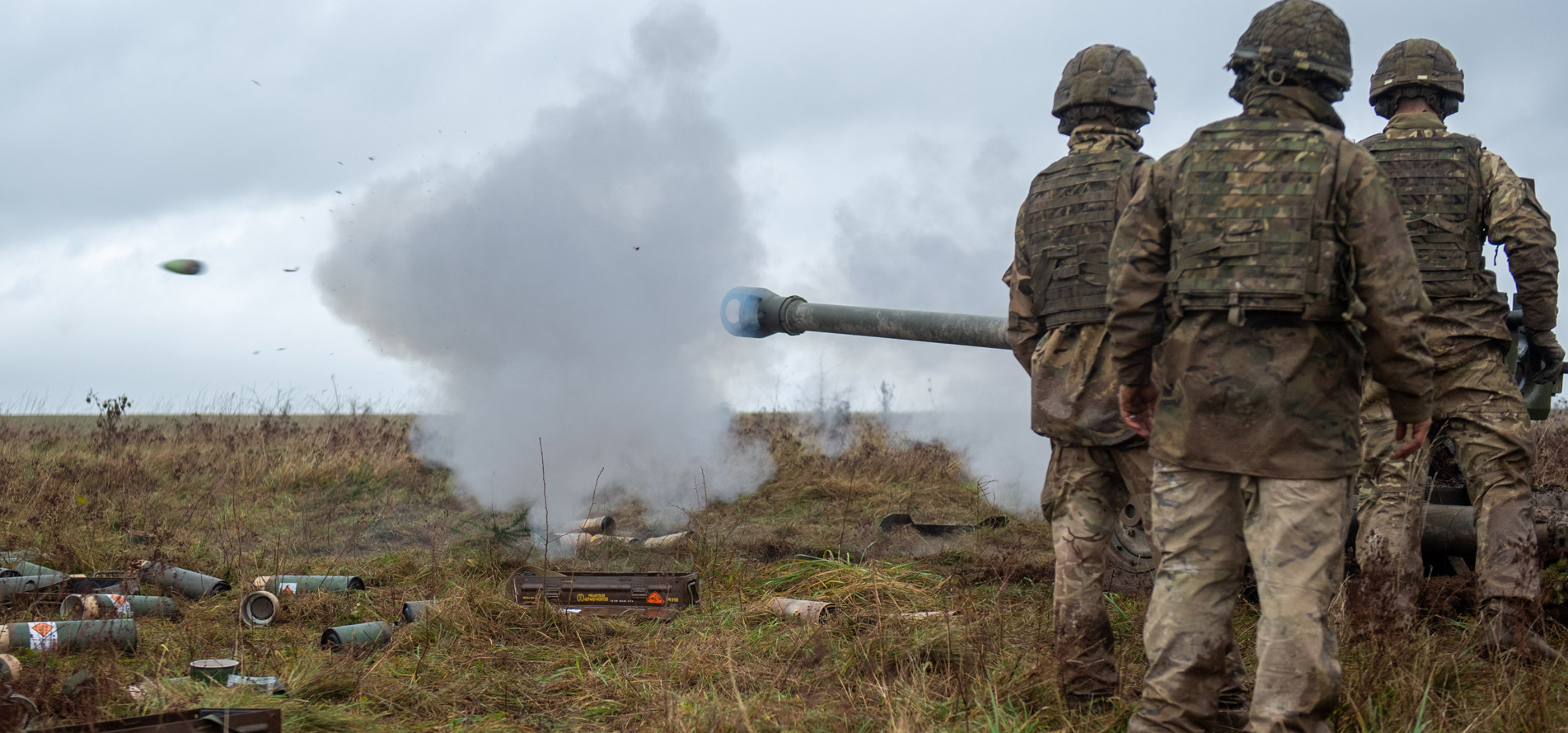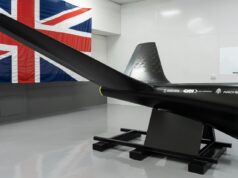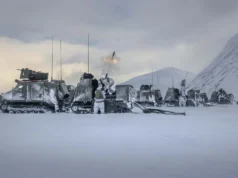The British Army say that Colchester’s airborne gunners have worked with Royal Air Force helicopters to demonstrate their specialist ability to fire and manoeuvre by air.
According to a release, 7th Parachute Regiment Royal Horse Artillery (7 Para RHA) carried out a battery raid on Salisbury Plain, with seven 105mm Light Guns and the soldiers that fire them lifted between positions by three Chinook and four Puma helicopters.
“Exploiting the pace and reach of helicopters to out manoeuvre the enemy is a key skill for 7 Para RHA as part of 16 Air Assault Brigade, the British Army’s global response force.”
7 Para RHA Commanding Officer Lieutenant Colonel Justin Baker said:
“For both the gunners on the ground and the aircrew in the helicopters this has been a hugely complex task, requiring a lot of effort and co-ordination. To be able to work at this scale, which we haven’t done for a few years, has meant we’ve really polished our skills and learnt a lot about how we can work together to deliver air manoeuvre operations.”

The raid took place as part of Exercise Cypher Strike, which has seen the full range of 7 Para RHA skills and capabilities tested over three weeks (18th November to the 6th of December) to show their readiness for short- notice operations around the world.
Fire Support Teams, who coordinate artillery and close air support for troops on the ground, have been calling in fire missions for the guns to engage, while the gun teams were constantly on the move to avoid become targets themselves.













A battery with 7 guns?
Thought the regiment only had 2 batteries of 6.
Could it be they turned out with elements from both batteries?
Lets hope it doesn’t represent an enforced upper limit on what they can actually deploy…
The army has been particularly badly served in recent years.
Yes that did cross my mind.
Mate that’s unfortunately the amount they could man for the Ex! Spoke to my bro, it was a Reg Ex starting at the lower end of the scale, leading up to Bty plus deployment, and Gunnery and air skills ex. Getting all the crows up to speed in air skills and technical training. They used to work with the Battalion all time but now all arms training, and combined arms training is few and far between in the Bde.
Jesus.
Yes my son?
🙂
It would be interesting to see an analysis of where the Artillery actually stand now and where the Army see the future for big guns.
Australian Army Chinooks slinging M777 155mm howitzers and shells during Exercise Talisman Sabre 2019. The guns were airlifted from HMAS Canberra’s flight deck in support of an amphibious assault.
http://images.defence.gov.au/20190714ran8108462_179.jpg
Despite the official caption on the ADF website these were Australian rather than US Chinooks. No US Army Chinooks deployed to TS19 although Japanese CH47s did. Zooming in on the image shows the Kangaroo markings on the fuselage.
Typically the M777’s are airlifted two at a time since the Canberra Class would normally embark no more than 2 CH47F’s alongside MRH90 and ARH Tigers. Both Canberra Class LHDs operating as a task force could airlift 4 guns in a single sortie from ship to shore.
http://images.defence.gov.au/190716-Z-MA638-4005_1.jpg
Australian Army Chinooks slinging M777 155mm howitzers and shells during Exercise Talisman Sabre 2019. The guns were airlifted from HMAS Canberra’s flight deck in support of an amphibious assault.
http://images.defence.gov.au/20190714ran8108462_179.jpg
Despite the official caption on the ADF website these were Australian rather than US Chinooks. No US Army Chinooks deployed to TS19 although Japanese CH47s did. Zooming in on the image shows the Kangaroo markings on the fuselage.
Typically the M777’s are airlifted two at a time since the Canberra Class would normally embark no more than 2 CH47F’s alongside MRH90 and ARH Tigers. Both Canberra Class LHDs operating as a task force could airlift 4 guns in a single sortie from ship to shore.
http://images.defence.gov.au/190716-Z-MA638-4005_1.jpg
I am not sure on viability of this tactic any more, especially when using 105 guns. Due to their shorter range, this requires them being placed much nearer the fight. With today’s plethora of artillery spotting radar, UAVs and SHORAD. Not only is the artillery in greater danger of being spotted and targeted, but so is the Chinook/Merlin picking them up etc. As much as the 105 is light and easily airlifted, its range is no longer competitive, especially when facing against other systems that are 152mm or greater.
Personally, I think the days of towed artillery are numbered. This is because of the amount of time it takes to set up and then “break camp”. In today’s conflicts, especially against a peer Nation mobility is key, other wise you’ll be spotted and be on the end of something nasty coming your way. In somewhere like Afghan, where there was no opposing artillery except the odd improvised rocket, our 105s were put to good use. However, a 120mm mortar could have done the same job.
To my mind we need our gun artillery to be more mobile and self-sufficient. The obvious option is Boxer with a 155 artillery module, but also a version with a 120mm gun-mortar. For Norway or snowy ops we would need need a BV type of vehicle with a 120mm mortar, as wheeled vehicles are useless in the snow.
To be fair, while the 105mm is close support, ie max range 17.5 KM, it is very mobile, has an excellent number of fuse options, and can be very accurate in the direct fire mode. In fact one was set up specifically for that purpose in Sangin, when the lads were out on the ground! On high elevation, accurate, cheap and a real 24/7 option to those of us needing it! And from the towed in convoy position to a call for fire being requested it is expected to be in action in 2 minutes! And that’s pretty good. My bro is 7 RHA so he likes to waffle and keep me up to date lol
I don’t disagree for a fixed emplacement operating in a “benign” environment the 105 was really handy to have in your back pocket. If like the Dutch and Canadians who had Leopard and 120mm mortars there would have been flexibility on the type of fire that could be used, i.e. 120 tank round for door knocking and the mortar for emplaced resistance. The Dutch and Canadians became very adept at using their Leopards to breech compound walls, as the 120 HE round would have devastating secondary effects behind the wall compared to a breech charge.
My concern is twofold when using a 105 for this type of shoot and scoot tactic. The first is obviously the minimum and maximum range of the 105. Why minimum, because as a howitzer it will have a minimum range dead zone where the ballistic arc is too great to have plunging fire, especially when trying to suppress entrenched infantry. This is where the mortar is better, as it has plunging fire and can be set for danger close minimum range. Granted the 120 mortar doesn’t have the same maximum range as the 105 gun.
The other issue is the method of transporting the gun, ammo and crew. I agree it doesn’t take long to set up and fire the first round. But the drop-off and collection by helicopter by comparison takes ages. For a Wokka there are two methods of carrying the gun either externally or internally. The gun and ammo is hooked up to the aircraft whilst hovering, which when done then lands to get the crew on board, then takes off for the next location. Or, the aircraft lands and you manhandle the gun inside along with ammo and crew. In theory it sounds quite simple but takes a fair amount of co-ordination and if the weather’s dogs**t can take forever. The Wokka and to a lesser extent the Merlin are quite noisy, so their general location are easy to pinpoint. What’s more the Wokka has a rather large radar cross section so is easy to detect. A SHORAD system like Russia’s Pantsir, was supposed to be designed to take out low flying aircraft and in particular attack helicopters. Something like a Chinook would be easy meat for it, especially as the Wokka cannot fly at max chat with an underslung load. This is my main concern with this type of tactic. The slow and then hovering Chinook/Merlin in a peer vs peer conflict where the opposition have access to lots of UAVs, ground based radar and SHORAD would make this type of mission extremely risky.
In Afghan, the internal carriage of a 105 was used a number of times in support of Ops. The Wokka would fly to nearby mountain, land, wheel out the gun, wait for a fire mission. After the fire mission was completed, the aircraft’s internal winch would pull the gun back in and they’d fly to the next hill top, where they’d repeat the process.
Totaly aware of that, and the issue with peer on peer. The 105 is simply not effective against tier 1 enemy with a decenct counter Bty capability, and the 105 shell doesnt realy cut it. However the 105 lads in my FOb, especially on Herrick 8 were firing charge 1, just skimming the FOB wall, using Proximity normal and high, which was effective and had results when we next went out. The close support aspect is always better for those of us on the welcoming and supported end. And living tongue in chhek with the 7RHA lads and thie FSTs we got a decent working relationship. We did call in rockets etc but they did take quite a while to turn up, as did Apaches, however the 105 was allways on call, 100% of the time. But yes, peer on peer the gun and system is well past its best and someting new is needed, but alas we will probably not see for a while.
We were doing that with 105mm and 155mm howitzers in Vietnam in the 1960s!